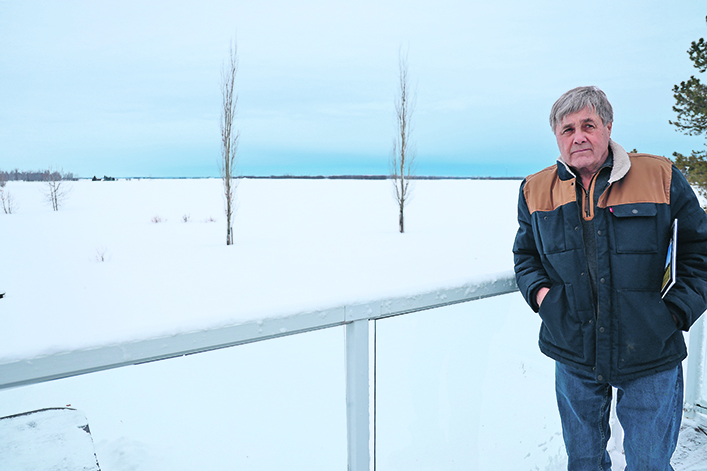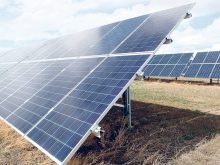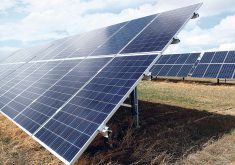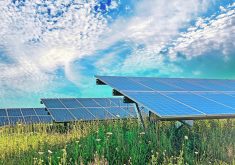140-acre solar farm near Calmar, Alta., is one of three that the Voltarix Group wants to build in the province
CALMAR, Alta. — Carol Ann McKell was an environmentalist before it was cool. The former schoolteacher taught her students how to sew cloth shopping bags, took them on outdoor nature hikes and talked about the importance of wind and solar power almost 30 years ago.
McKell and her husband, Robert, support green technology, but do not support the transformation of a quarter section of prime Alberta farmland into a solar farm just a few metres from their front door.
“I totally support anything green, but it’s the location,” said Robert. “This is the best farmland in Alberta.”
If the solar farm is approved, the couple will see more than 41,500 solar panels instead of a sunset over a canola crop.
Twenty years ago, the McKells bought a three-acre parcel of land outside Calmar. They rebuilt a hip-roof barn, out buildings and house as their retirement home.
Before Christmas, they heard “through the grapevine” that the view from their window was slated to become a 140-acre solar farm.
It is one of three proposed by Voltarix Group, an Edmonton-based energy company. Each of the proposed solar farms at Calmar, Drayton Valley and Spruce Grove are expected to produce about 25 megawatts of power.
According to the company website, the Calmar Creekside project will “generate roughly 32,500 megawatt hours of energy, offsetting approximately 5,000 homes’ electricity needs and displacing 17,150 tonnes of carbon from the environment, working towards Alberta’s goal of sourcing 30 percent of the province’s electricity from renewable sources by 2030.”
“All the power the solar farm will produce will be eaten locally by the local farms and towns. It is putting power where it is required,” said Dave Debruin, director of operations with Voltarix.
He said the company considered about 200 potential sites across the province for solar farms and found the Calmar site ideal because of its proximity to a power substation on the same quarter section as the planned solar farm and adjoining distribution lines.
“We are a solar farm development corporation. We search for properties all over Alberta to develop solar farms. We look for all the sites that have substations on them to develop solar farms.
“The closer you are to a substation, the more it makes economic sense. A lot of sites just don’t pencil out. Unless the power lines are already at the site, the costs to put them there doesn’t make it feasible,” said Debruin.
“Being tied right in there makes it a very viable property.”
But a good site for a solar farm developer isn’t necessarily a good site for Leduc County Mayor Tanni Doblanko and the other municipal councillors.
“The majority of council believes we need to be moving in the direction of green energy, but they didn’t believe this was the right place for it,” said Doblanko, who lives about half a mile from the proposed solar farm.
“There is room for this solar farm in Leduc County, but I am a firm believer this is not the best location for it, and we would be very happy to work with Voltarix to find another location.”
Leduc County rated the land at the proposed site as the best land in the county, with six to 10 inches of rich topsoil. County councillors’ support of farmland preservation has previously led them to reject a capital region expansion proposal until it recognized and preserved agricultural land.
When Voltarix made a presentation to Leduc County in December, it quoted the county’s own economic development plan that invited new development and green energy. However, the county had envisioned new energy projects on poorer-quality land, said Doblanko.
“We really had wanted to see this stuff closer to industrial parks. We hadn’t contemplated it would end up in the highest quality farmland in the county. Nobody is going to object to a project on industrial land or marginal land,” she said.
There are no bylaws preventing the solar farm from locating on the proposed quarter section because it is zoned agricultural and the solar farm will have an agriculture component.
Utility development is also allowed as a discretionary use on agricultural land. Project plans include some kind of agricultural use between and under the solar panels. Each panel will be mounted on a steel pipe one metre off the ground with 35 feet between each row of panels.
Debruin said the company has partnered with the agricultural group Young Agrarians to encourage young and local farmers interested in farming between the rows of panels.
“It is not like nothing is going to grow here. It’s in our best interests to continue agriculture activities on the site and have dual usage,” he said.

“We need to control the vegetation and what better way than to farm it? We are planning to continue farming the property.”
While nothing is finalized, Debruin said Voltarix has discussed haying the area between the panels, grazing it with sheep or working with young farmers to plant vegetables or other crops.
“We’re reaching out to the farming community. We have a couple of parties already interested in working with us. Fifty percent of the land space is still available for agriculture after it is developed.”
Neighbour and farmer Dwayne Buchak lives on the south side of the proposed solar farm and rents 40 acres of hay on the proposed quarter section.
“I have nothing against green energy, but surely to God you can find a better place to put green energy than on number one soil. There is lots of poor farmland to the south of us.”
Buchak believes the land under the panels will be mostly mole holes and weeds within a few years and will have little agriculture benefit.
“Eventually it’s going to be a whole whack of weeds and thistles.”
He and others have suggested the company place the panels on reclaimed coal land near the Genesee power plant, but Debruin said that land has already been identified by other companies.
Heather MacKenzie, executive director of Solar Alberta, said the number of solar farm projects will increase tenfold in the next two years, from 736 megawatts of utility to 9,174 megawatts. These are projects over five megawatts.
“When you add it all up and online and/or coming online, more than 10,000 megawatts in the next two years,” said MacKenzie.
“There is a huge rush on land right now. It is kind of like the gold rush. What we’re seeing is a massive rush. Once all the best solar land is taken, it will slow down.”
While most projects will be in southern Alberta or on inexpensive farmland, some will be on productive farmland, as in Leduc County.
In the United States, some counties have created solar siting guidelines to ensure solar farms are not placed on farmland. That comes with risks, said MacKenzie.
“We have a province that is generally not a fan of regulating. If it is more regulated, it will limit farmers and their ability to diversify their own household income. You have to be careful when establishing the guidelines to make sure you are not making it harder for farmers to survive,” she said.
“If it is about the arable land and food security, I think counties should be moving to make sure that is protected and there are agri-voltaics going up rather than pure solar farms. But if this is just about someone considering it an eyesore, that is all relative.”
For the McKells, the solar farm will certainly be an eyesore just outside their windows.
There is nothing Voltarix can do to fix that, said Debruin.
“That is a hard one to solve. … Me saying ‘I think they look great’ isn’t going to help them. It will definitely have a different look to the property. There is no way to solve that.”
The Alberta Utilities Commission has yet to approve the project. A virtual public engagement session was scheduled Jan. 31.

















